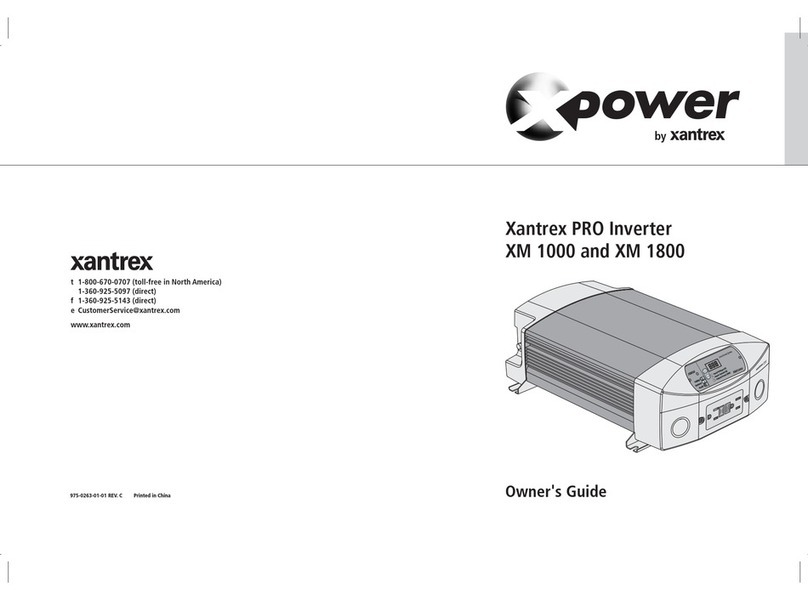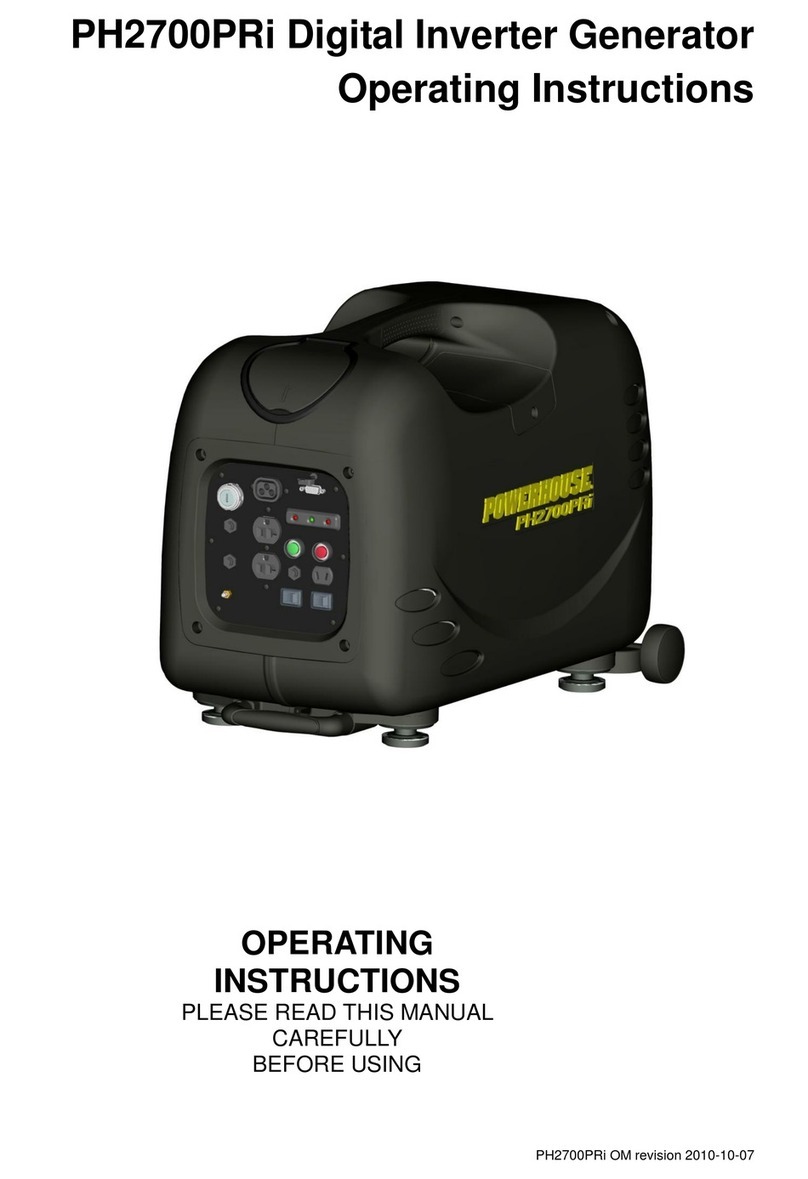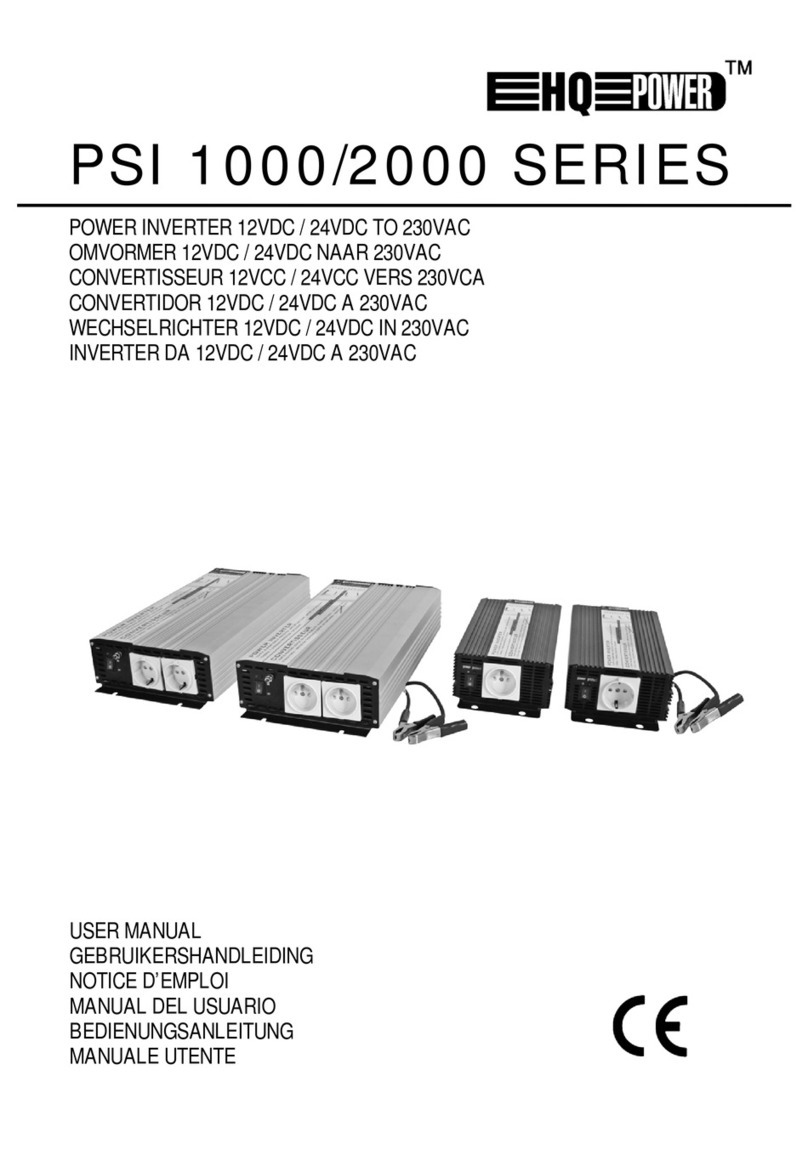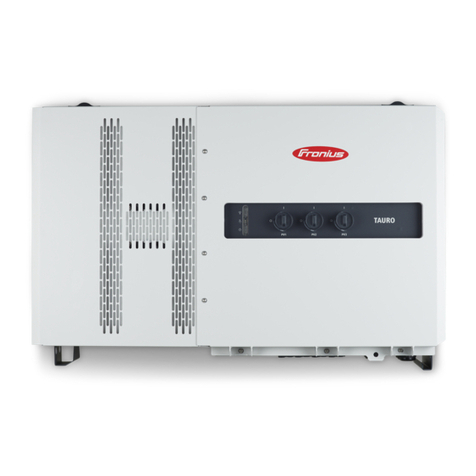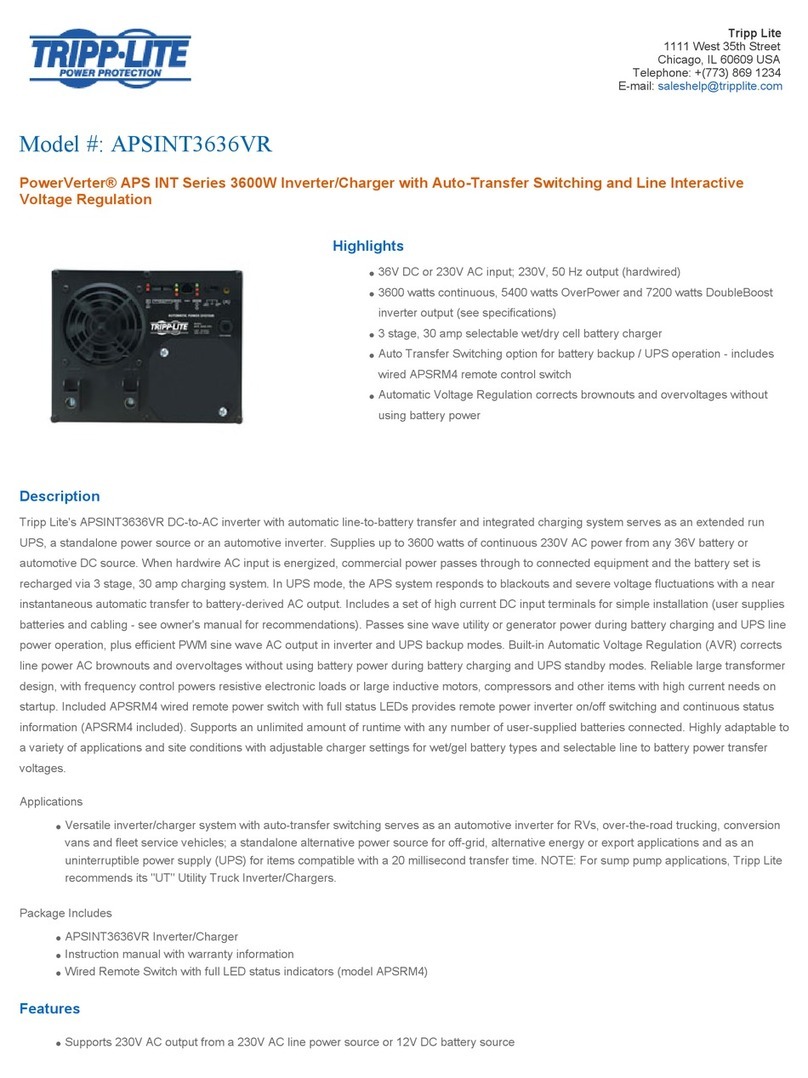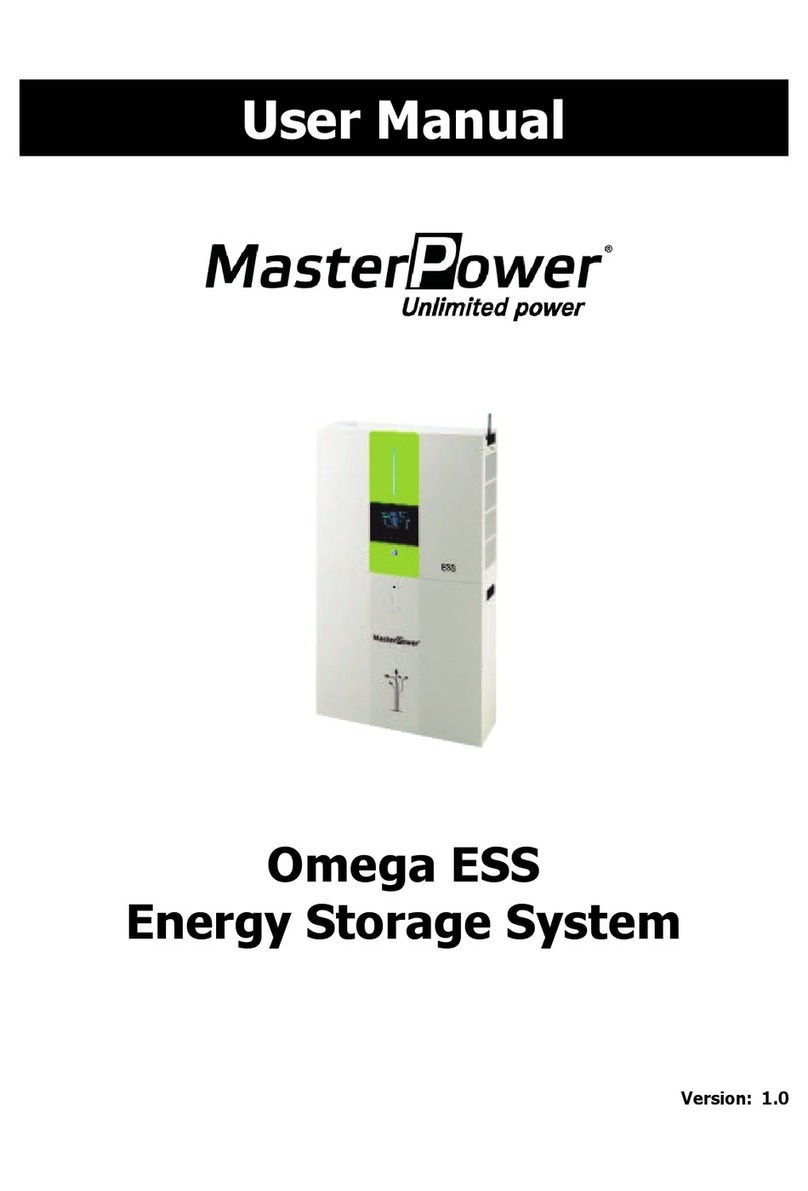Mecer IVR-1200MPPT User manual

USER MANUAL
IVR-1200MPPT/IVR-2400MPPT
Solar Inverter

Table of Contents
1. Introduction...................................................................................................................................................1
2. Important Safety Warning (SAVE THESE INSTRUCTIONS)......................................................................1
3. Product Overview .........................................................................................................................................2
4. Installation.....................................................................................................................................................2
5. Operation.......................................................................................................................................................5
6. Trouble Shooting ........................................................................................................................................14
7. Specifications .............................................................................................................................................15

1
1. Introduction
Thank you for purchasing this solar inverter. This simple solar inverter is designed to power your home
appliances or precious 3C electronics. It also can handle motor-type loads with high surge power such as
vacuums, small freezers, or drills. With built-in MPPT solar charger, it can convert solar power to battery power
and provide continuous power to connected equipment during night time.
This manual is for qualified personnel. The tasks described in this manual may be performed by qualified
personnel only.
2. Important Safety Warning (SAVE THESE INSTRUCTIONS)
Before using the inverter, please read all instructions and cautionary markings on the unit, this
manual and the batteries.
General Precaution-
CAUTION! The unit is designed for indoor use. Do not expose this unit to rain, snow or liquids of any type.
CAUTION! To reduce risk of injury, only use qualified batteries from qualified distributors or manufacturers.
Any unqualified batteries may cause damage and injury. Do NOT use old or overdue batteries. Please check the
battery type and date code before installation to avoid damage and injury.
CAUTION! Authorized service personnel should reduce the risk of electrical shock by disconnecting AC, DC and
battery power from the inverter before attempting any maintenance or cleaning or working on any circuits
connected to the inverter. Turning off controls will not reduce this risk. Internal capacitors can remain charged
for 5 minutes after disconnecting all sources of power.
CAUTION! Do not disassemble this inverter yourself. It contains no user-serviceable parts. Attempt to service
this inverter yourself may cause a risk of electrical shock or fire and will void the warranty from the
Manufacturer.
CAUTION! To avoid a risk of fire and electric shock, make sure that existing wiring is in good condition and that
the wire is not undersized. Do not operate the Inverter with damaged or substandard wiring.
CAUTION! To reduce risk of fire hazard, do not cover or obstruct the cooling fan.
CAUTION! Do not operate the inverter if it has received a sharp blow, been dropped, or otherwise damaged in
any way. If the inverter is damaged, called for an RMA (Return Material Authorization).
WARNING: There are no user-replaceable parts inside of the inverter. Do not attempt to service the unit
yourself.
WARNING! It's very important for system safety and efficient operation to use appropriate external battery
cable. To reduce risk of injury, external battery cables should be UL certified and rated for 105°C or higher. And
do not use copper cables less than 6AWG or 10AWG*2.
CAUTION! Do not disassemble the inverter. Contact with the qualified service center when service or repair is
required.
WARNING! Provide ventilation to outdoors from the battery compartment. The battery enclosure should be
designed to prevent accumulation and concentration of hydrogen gas at the top of the compartment.
CAUTION! Use insulated tools to reduce the chance of short-circuit when installing or working with the inverter,
the batteries, or other equipments attached to this unit.
CAUTION! For battery installation and maintenance, read the battery manufacturer's installation and
maintenance instructions prior to operating.
Personnel Precaution -
CAUTION! Careful to reduce the risk or dropping a metal tool on the batteries. It could spark or short circuit the
batteries and could cause an explosion.
CAUTION! Remove personal metal items such as rings, bracelets, necklaces, and watches when working with
batteries. Batteries can produce a short circuit current high enough to make metal melt, and could cause severe
burns.
CAUTION! Avoid touching eyes while working near batteries.
Conventions used:
WARNING! Warnings identify conditions or practices that could result in personal injury;
CAUTION! Caution identify conditions or practices that could result in damaged to the unit or other
equipment connected.

2
CAUTION! Have plenty of fresh water and soap nearby in case battery acid contacts skin, clothing, or eyes.
CAUTION! NEVER smoke or allow a spark or flame in vicinity of a battery.
CAUTION! If a remote or automatic generator start system is used, disable the automatic starting circuit or
disconnect the generator to prevent accident during servicing.
3. Product Overview
4. Installation
NOTE: Before installation, please inspect the unit. Be sure that nothing inside the package is damaged.
Mounting the unit
The unit ONLY can be mounted vertically to a wall surface.
Please follow below steps:
1. Turn off the unit before mounting.
2. Select an appropriate mounting location. Mark four mounted ends as shown in chart.
3. Drill four marks by screws.
4. Mount the unit by positioning the key-hole slots over the mounting screws.
Connect to Utility and Charge
Plug in the AC input cord to the wall outlet. The unit will automatically charge the connected external battery
even though the unit is off.
Connect to External Battery
Step 1- Install a DC Breaker in a positive battery line. The rating of the DC Breaker must be according to the
inverter's battery current (100 Amp). Keep the DC breaker off.
Step 2 - Remove insulation sleeve 18 mm for positive and negative conductors.
Step 3- Connect battery cables to the external batteries.
Note: For the user operation safety, we strongly recommend that you should use tapes to isolate the battery
terminals before you start to operate the unit.
1. Power switch
2. Status indicator
3. Charging indicator
4. Fault indicator
5. Function buttons
(Please see the Operation section
for the details)
6. LCD display
7. AC input
8. AC output socket
9. Input circuit breaker
10. External battery connectors
11. Solar connector
12. DC fuse
13. Charging voltage switch (Please
check specifications for the details)

3
1) Single battery connection: When using a single battery, its voltage must be equal to the Nominal DC
Voltage of the unit
2) Multiple batteries in series connection(Refer to Fig. 3): All batteries must be equal in voltage and
amp hour capacity. The sum of their voltages must be equal to the nominal DC Voltage of the unit.
Fig 3
3) Multiple batteries in parallel connection(Refer to Fig. 4): Each battery's voltage must be equal to the Nominal
DC Voltage of the unit.
Fig 4
Step 4- Make sure to connect the polarity of battery side and the unit correctly.
Positive pole (Red) of battery to the positive terminal (+) of the unit.
Negative pole (Black) of battery to the negative terminal (-) of the unit.
Step 5-Take the DC breaker on.
Connect to Solar Panel
CAUTION: Before connecting to PV modules, please install separately a DC circuit breaker between inverter
and PV modules.
WARNING! All wiring must be performed by a qualified personnel.
WARNING! It's very important for system safety and efficient operation to use appropriate cable for PV module
connection. To reduce risk of injury, please use the proper recommended cable size as below.
Typical Amperage
Gauge
Torque Value
Conductor cross-section (mm2)
55A
8 AWG
1.6 Nm
8.3
Step 1- Connect one cable to the positive (+) pole of solar panel and solar charger positive (+) terminal.
Step 2- Connect the other cable to the negative (-) pole of solar panel and solar charger negative (-) terminal.
Step 3- Before connecting photovoltaic solar panels, a matching circuit breaker must be connected in series.
The maximum value for PV Isc is 55A.
Breaker

4
PV Module Selection:
When selecting proper PV modules, please be sure to consider below requirements first:
1. Open circuit Voltage (Voc) of PV modules not exceeds max. PV array open circuit voltage of inverter.
INVERTER MODEL
IVR-1200MPPT
IVR-2400MPPT
Charging Current (MPPT)
55 Amp
System DC Voltage
12Vdc
24Vdc
Operating Voltage Range
15~80Vdc
30~80Vdc
Max. PV Array Open Circuit Voltage
100Vdc
2. Max. Power Voltage (Vmpp) of PV modules should be close to best Vmp of inverter or within Vmp range to get
best performance. If one PV module cannot meet this requirement, it’s necessary to have several PV modules
in series connection. Refer to below table.
Model
Best Vmp range
IVR-1200MPPT
15V~18V
IVR-2400MPPT
30V~32V
Note: * Vmp: panel max power point voltage.
The PV charger efficiency is maximized while PV system voltage is close to Best Vmp range.
Maximum PV module numbers in Series: Vmpp of PV module * X pcs ≒Best Vmp of Inverter
PV module numbers in Parallel: Total PV module numbers / Maximum PV module numbers in series
Total PV module numbers = Max. Charging power of inverter / Pmax of PV module / 0.8 (MPPT
conversion rate)
Take IVR-1200MPPT inverter as an example to select proper PV modules. After considering Voc of PV module not
exceeds 100Vdc and max.
Maximum Power (Pmax)
150W
Max. PV module numbers in series
1→18.1 × 1 ≈15~ 18
Max. Power Voltage Vmpp(V)
18.1V
Max. Power Current Impp(A)
8.31A
Total PV module numbers
7→(753W ÷ 150W)/0.8= 6.3 ≒7
PV module numbers in parallel
7 / 1 = 7
Open Circuit Voltage Voc(V)
22.4V
Short Circuit Current Isc(A)
8.66A
Maximum PV module numbers in Series: 1
PV module numbers in Parallel: 7
Total PV module numbers: 7
Take IVR-2400MPPT inverter as an example to select proper PV modules. After considering Voc of PV module not
exceeds
100Vdc and max.
Maximum Power (Pmax)
260W
Max. PV module numbers in series
1→30.9 × 1 ≈30 ~ 32
Max. Power Voltage Vmpp(V)
30.9V
Max. Power Current Impp(A)
8.42A
Total PV module numbers
8→(1507W ÷ 260W)/0.8= 7.2 ≒8
PV module numbers in parallel
8 / 1 = 8
Open Circuit Voltage Voc(V)
37.7V
Short Circuit Current Isc(A)
8.89A
Maximum PV module numbers in Series: 1
PV module numbers in Parallel: 8
Total PV module numbers: 8

5
CAUTION: Please strictly follow installation procedure when you want to connect PV or DC
terminals. Don’t touch the DC terminals and the PV terminals by hand. Failure to follow these
instructions can result in serious electrical shock.
5. Operation
Power On/Off
Once the inverter has been properly installed, press the power switch to turn on the unit. The unit will work
automatically in line mode or inverter mode according to input utility power's status. When press the power
switch again, the unit will be turned off.
LED Indicators, Function Keys & Audible Alarms
There are three indicators in the front panel of the unit.
LED Indicator
Messages
Green
Solid On
Output is available in bypass mode
Flashing
Output is powered by battery in inverter mode
Green
Solid On
Battery is charging by SCC
Flashing
Battery is not charging by SCC while SCC power on
Red
Solid On
Fault mode
Flashing
battery low or overload warning
Function Keys
Function Key
Description
ESC
To exit setting mode
SCROLL
To go to next selection
ENTER
To confirm the selection in setting mode or enter setting
mode
Audible Alarms
Buzzer Audible Alarm
Messages
Inverter Mode (Low-battery Voltage)
Buzzing every 1 seconds
110% overload warning
Buzzing every 0.5 second
Overcharge
Buzzing continuously
Fault mode
Buzzing continuously

6
LCD Display
Display
Function
Input source information
Indicates the AC input
Indicates the PV input
Indicates input voltage, input frequency, PV voltage, charging current, battery voltage,
Configuration Program and Fault Information
Indicates the setting programs.
Indicates the warning and fault codes.
Warning: Flashing with warning code
Fault: Lighting with fault code
Output Information
Indicates the output voltage, output frequency, load percent, load in VA, load in Watt,
main board firmware version and SCC firmware version
Battery Information
Indicates the Battery level by 0-24%, 25-49%, 50-74% and 75-100% in battery mode,
charging status in line mode.
In AC mode, it will present battery charging status.
Status
Battery voltage
LCD Display
Constant
Current mode /
Constant
Voltage mode
< 11Vdc/pcs
4 bars will flash in turns.
11Vdc ~ 11.5Vdc/pcs
Bottom bar will be on and the other three
bars will flash in turns.
11.5Vdc ~ 12.5Vdc/pcs
Bottom two bars will be on and the other
two bars will flash in turns.
> 12.5Vdc/pcs
Bottom three bars will be on and the top
bar will flash.
Floating mode. Batteries are fully charged.
4 bars will be on.
In battery mode, it will present battery capacity.
Battery Voltage
LCD Display
< 11Vdc/pcs
11.0Vdc ~ 11.5Vdc/pcs
11.5Vdc ~ 12.5Vdc/pcs
> 12.5Vdc/pcs
Load Information
Indicates overload.
Indicates the load level by 0-24%, 25-49%, 50-74%, and 75-100%.
0%~24%
25%~49%
50%~74%
75%~100%
Mode operation information
Indicates unit connects to the mains.
Indicates unit connects to the PV panel

7
Indicates load is supplied by utility power.
Indicates the utility charger circuit is working.
Indicates the DC/AC inverter circuit is working.
LCD Setting
After pressing and holding ENTER button for 3 seconds, the unit will enter setting mode. Press “SCROLL”button
to select setting programs. And then, press “ENTER”button to confirm the selection or ESC button to exit.
Setting Programs
Program
Description
Selectable option
00
Exit setting mode
Escape
01
AC input voltage
range
Wide (default)
If selected, acceptable AC input voltage range will be
within 90-280VAC.
Narrow
If selected, acceptable AC input voltage range will be
within 170-280VAC.
02
Battery type
AGM(Default)
Flooded
User-defined
03
Max AC charging
current
25A(default)
10A
04
Bulk charging (C.V
voltage)voltage
IVR-1200MPPT model: 14.3V default setting for lead acid battery. 14.6V default
setting for lithium battery.
IVR-2400MPPT model: 28.6V default setting for lead acid battery. 29.2V default
setting for lithium battery.
If self-defined is selected in program 02, this program can be set up. Setting
range is from 13.0V to 14.6V for IVR-1200MPPT model and increment of each
click is 0.1V. Setting range is from 26.0V to 29.2V for IVR-2400MPPT model
and increment of each click is 0.2V.
05
Floating charging
voltage
IVR-1200MPPT model default setting: 13.5V

8
IVR-2400MPPT model default setting: 27.0V
If self-defined is selected in program 02, this program can be set up. Setting
range is from 13.0V to 14.6V for IVR-1200MPPT model and increment of each
click is 0.1V. Setting range is from 26.0V to 29.2V for IVR-2400MPPT model and
increment of each click is 0.2V.
06
Low DC cut-off
voltage
IVR-1200MPPT default setting: 10.5V
IVR-2400MPPT default setting: 21V
Setting range is from 9.9V to 12.0V for IVR-1200MPPT model and increment of
each click is 0.1V Setting range is from 19.8V to 24.0V for IVR-2400MPPT model
and increment of each click is 0.2V. Low DC cut-off voltage will be fixed to
setting value no matter what percentage of load is connected.
07
Output source
priority:
To configure load
power source
priority
Utility first (default)
Utility will provide power to the loads as first priority.
Solar and battery energy will provide power to the
loads only when utility power is not available.
Solar first
Solar energy provides power to the loads as first
priority.
If solar energy is not sufficient to power all connected
loads, battery energy will supply power the loads at
the same time.
Utility provides power to the loads only when any one
condition happens:
- Solar energy is not available
- Battery voltage drops to low-level warning voltage or
the setting point in program 10.
SBU priority
Solar energy provides power to the loads as first
priority.
If solar energy is not sufficient to power all connected
loads, battery energy will supply power to the loads at
the same time.
Utility provides power to the loads only when battery
voltage drops to either low-level warning voltage or
the setting point in program 10.
08
Maximum charging
current: To
configure total
charging current for
solar and utility
chargers.
(Max. charging
current = utility
charging current +
solar charging
current)
10A
20A
30A
40A
55A (default)
09
Output frequency
50Hz (default)
60Hz

9
10
Setting voltage
point back to utility
source when
selecting “SBU
priority” or “Solar
first” in program 07.
Available options in IVR-1200MPPT model:
11.0V
11.3V
11.5V (default)
11.8V
12.0V
12.3V
12.5V
12.8V
Available options in IVR-2400MPPT model:
22.0V
22.5V
23.0V (default)
23.5V
24.0V
24.5V
25.0V
25.5V
11
Setting voltage
point back to
battery mode when
selecting “SBU
priority” or “Solar
first” in program 07.
Available options in IVR-1200MPPT model:
Battery fully
charged
12.0V
12.3V
12.5V
12.8V
13.0V
13.3V
13.5V (default)
13.8V
14.0V

10
11
Setting voltage
point back to
battery mode when
selecting “SBU
priority” or “Solar
first” in program 07
Available options in IVR-2400MPPT model:
Battery fully
charged
24V
24.5V
25V
25.5V
26V
26.5V
27V (default)
27.5V
28V
12
Charger source
priority:
To configure
charger source
priority
If this inverter/charger is working in Line, Standby or Fault mode, charger
source can be programmed as below:
Utility first
Utility will charge battery as first priority.
Solar energy will charge battery only when utility power
is not available.
Solar first
Solar energy will charge battery as first priority.
Utility will charge battery only when solar energy is not
available.
Solar and utility
Solar energy and utility will charge battery at the same
time.
Only Solar
Solar energy will be the only charger source no matter
utility is available or not.
If this inverter/charger is working in Battery mode, only solar energy can
charge battery. Solar energy will charge battery if it's available and sufficient.
13
Auto return to
default display
screen
Return to default
display screen
(default)
If selected, no matter how users switch display screen,
it will automatically return to default display screen
(Input voltage /output voltage) after no button is
pressed for 1 minute.
Stay at latest screen
If selected, the display screen will stay at latest screen
user finally switches.
14
Beeps while primary
source is
interrupted
Alarm on(default)
Alarm off

11
Display Setting
The LCD display information will be switched in turns by pressing “SCROLL”key. The selectable information is
switched as below order: input voltage, input frequency, PV voltage, charging current, battery voltage, output
voltage, output frequency, load percentage, load in Watt, load in VA, load in Watt, DC discharging current, main
CPU Version and second CPU Version.
Selectable
information
LCD display
Selectable
information
LCD display
Input voltage/Output
voltage
(Default Display
Screen)
Input Voltage=230V,
output voltage=230V
Load
percentage
Load percent=70%
Input frequency
Input frequency=50Hz
Load in VA
When connected load is lower
than 1kVA, load in VA will present
xxxVA like below chart.
When load is larger than 1kVA
(≧1KVA), load in VA will present
x.xkVA like below chart.
PV voltage
PV voltage=30V
Load in Watt
When load is lower than 1kW,
load in W will present xxxW like
below chart.
When load is larger than 1kW
(≧1KW), load in W will present
x.xkW like below chart.
Charging current
(if PV normal)
Charging current=55A
Main CPU
version
checking
Main CPU version 00001.01

12
Battery voltage
Battery voltage=25.5V
Secondary CPU
version
checking
Secondary CPU version 00003.03
Output frequency
Output frequency=50Hz
Operating Mode Description
Operation mode
Description
LCD display
Standby mode
Note:
*Standby mode: The inverter is
not turned on yet but at this
time, the inverter can charge
battery with AC bypass output.
Utility input bypass to
output, charger
available, LCD backlight
is off
Charging by utility and PV energy.
Charging by utility.
Charging by PV energy.
Line Mode
The unit will provide
output power from the
mains. It will also
charge the battery at
line mode.
Charging by utility and PV energy.
Charging by PV energy.
Charging by utility.
Battery Mode
The unit will provide
output power from
battery and PV power.
Power from battery and PV energy.
Power from battery only.

13
Fault Reference Code
Fault Code
Fault Event
Icon on
Fault Code
Fault Event
Icon on
00
Output short circuit
05
Fan locked
01
Over load time out
06
Over temperature
03
Output voltage too
high
08
Over charge
Warning Indicator
Warning Code
Warning Event
Icon flashing
01
Over load
02
Battery low

14
6. Trouble Shooting
Use the table below to solve minor problems.
Problem
LCD/LED/Buzzer
Explanation / Possible cause
What to do
When power fails,
the backup time is
shorten.
Battery low alarm
issue quickly.
Battery voltage is too low.
Charge the unit at least 8
hours.
Battery capacity is not full even
after charge the unit for at least 8
hours.
Check the date code of the
battery. If the batteries are
too old, replace the batteries.
Mains exist but the
unit works in
battery mode.
Input voltage is
displayed as 0 on the
LCD and green LED is
flashing.
Input protector is tripped
Check if AC breaker is tripped
and AC wiring is connected
well.
Green LED is flashing.
Insufficient quality of AC power.
(Shore or Generator)
1. Check if AC wires are too
thin and/or too long.
2. Check if generator (if
applied) is working well or if
input voltage range setting is
correct. (NarrowWide)
Green LED is flashing.
Set “Solar First”as the priority of
output source.
Change output source priority
to Utility first.
No LED display on
the front panel
when the utility
power is normal.
No LED display.
Battery is not connected well.
Check the external battery
cable and terminal. Make sure
all the battery connections to
the unit are all correct.
Battery defect.
Replace the batteries.
Buzzer beeps
continuously and
red LED is on.
Fault code 00
Output short circuited.
Check if wiring is connected
well and remove abnormal
load.
Fault code 01
Overload error. The inverter is
overload 110% and time is up.
Reduce the connected load by
switching off some
equipment.
Fault code 03
Output voltage too high
Return to repair center.
Fault code 05
Fan fault
Replace the fan.
Fault code 06
Internal temperature of inverter
component is over 100°C.
Check whether the air flow of
the unit is blocked or whether
the ambient temperature is
too high.
Fault code 08
Battery is over-charged.
Return to repair center.
The battery voltage is too high.
Check if spec and quantity of
batteries are meet
requirements.
If there is any abnormal situations occur, which doesn't list above, please call the service people immediately
for professional examine.

15
7. Specifications
MODEL
IVR-1200MPPT
IVR-2400MPPT
CAPACITY
1200VA/1000W
2400VA/1800W
POWER FACTOR
0.83
0.75
INPUT
Voltage
220-240 VAC
Voltage Range
90-280 VAC
Nominal Operating Frequency
50/60Hz
Maximum Input Current
10A
13A
OUTPUT
Nominal Output Voltage
220-240 VAC
Voltage Regulation (Batt. Mode)
+/-10%
Output Frequency Range
50/60Hz
Nominal Output Current
5.2A
10.4A
Inrush Current
10A
13A
Maximum Output Fault Current
6.9A
13.6A
Transfer Time
20 ms typical
Waveform
Simulated Sine Wave
BATTERY
Battery Voltage
12 VDC
24 VDC
Maximum Battery Discharging Current
100A
90A
Floating Charge Voltage
13.7 VDC ± 0.5 VDC
27.4 VDC ± 1 VDC
CV Charging
Voltage
Lead Acid Battery
14.3 VDC ± 0.5 VDC
28.6 VDC ± 1 VDC
Lithium Battery
14.6 VDC ± 0.5 VDC
29.2 VDC ± 1 VDC
Cut Off Voltage
10.5 VDC ± 0.5 VDC
21.0 VDC ± 1 VDC
Maximum AC Charging Current
10 A or 25 A
10 A or 25 A
SOLAR CHARGER
Solar Charger Type
MPPT
Maximum PV Array Open Circuit Voltage
100 VDC
MPP Range @ Operating Voltage
15 ~ 80 VDC
30 ~ 80 VDC
Max. PV array Input Power
825W
1650W
Max. PV array Power to support
660W
1320W
Maximum Solar Charging Current
55 A
55 A
Maximum Charging Current
(Utility +SCC)
55 A
55 A
PHYSICAL
Dimension (DxWxH) mm
272 x 212 x 127
Net Weight (kgs)
4.5
4.8
Protective Class
I
Ingress Protection Rating
IP20
ENVIRONMENT
Humidity
0 ~ 90% RH (No condensing)
Operating Temperature
0 ~ 55°C
Altitude
0 ~ 1000 m
This manual suits for next models
1
Table of contents
Popular Inverter manuals by other brands
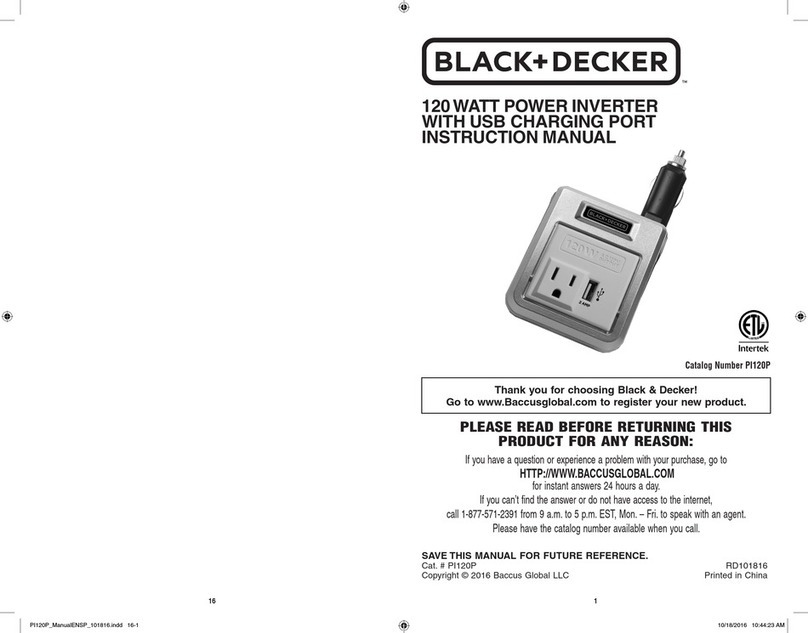
BLACK DECKER
BLACK DECKER PI120P instruction manual
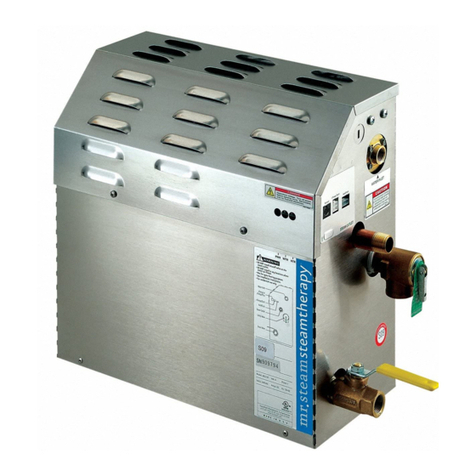
mr. steam
mr. steam MS-90E Installation, operation & maintenance manual
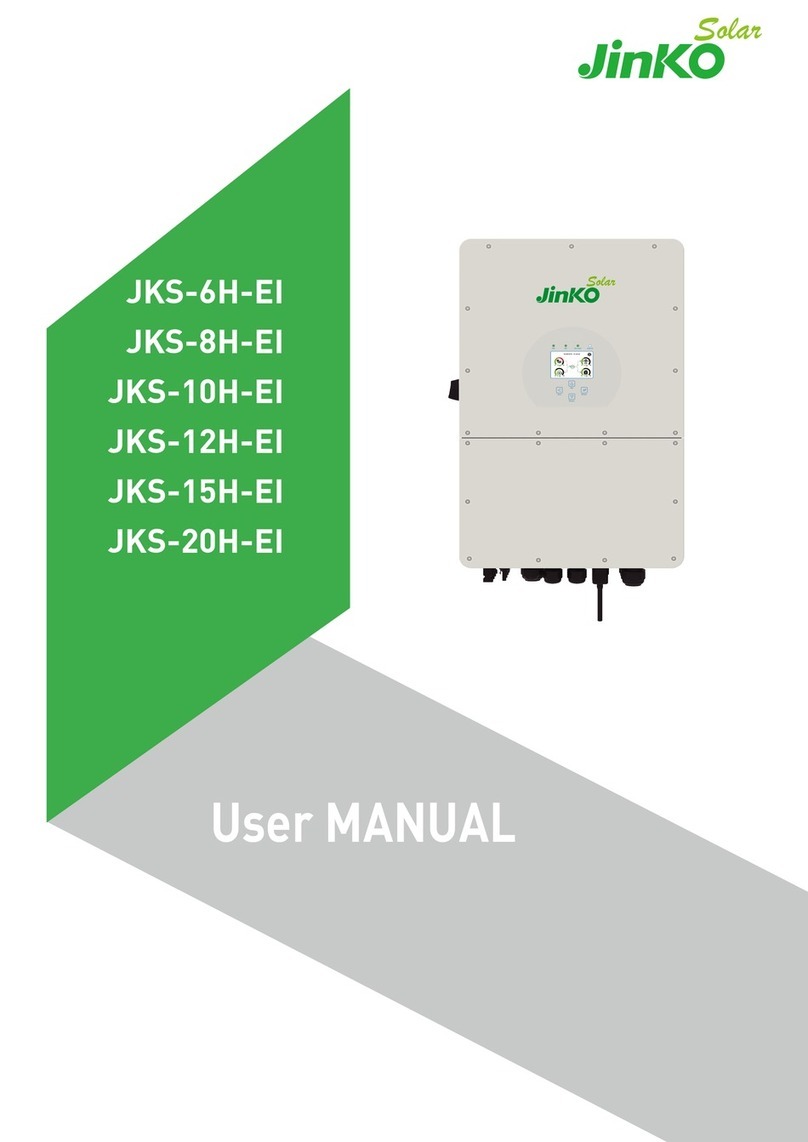
Jinko Solar
Jinko Solar JKS-6H-EI user manual
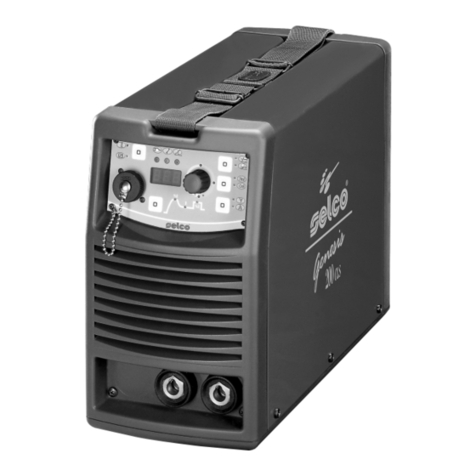
Sel
Sel Genesis 200 CLS Use and maintenance manual
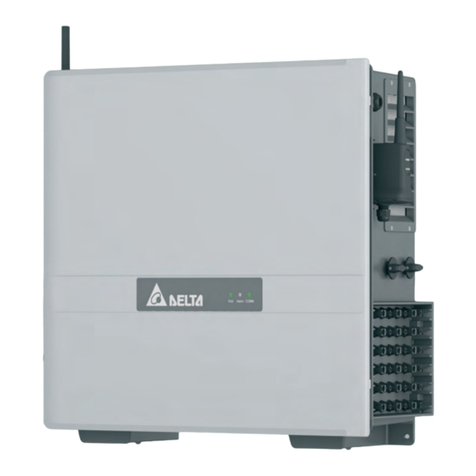
Delta
Delta M70A 260 Installation and operation manual
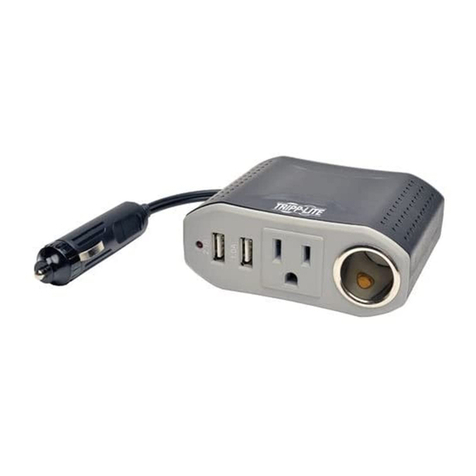
Tripp Lite
Tripp Lite PowerVerter PV100USB owner's manual
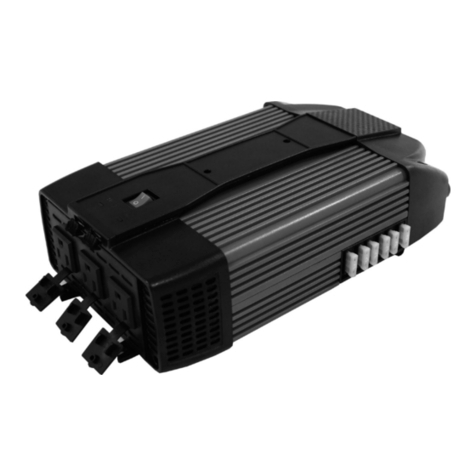
Power Fist
Power Fist 8940835 manual
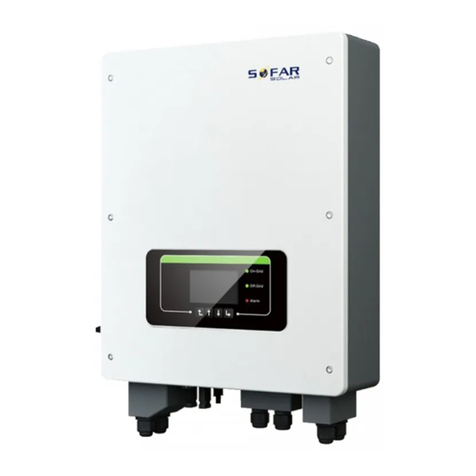
Sofar solar
Sofar solar HYD 4000-ES user manual
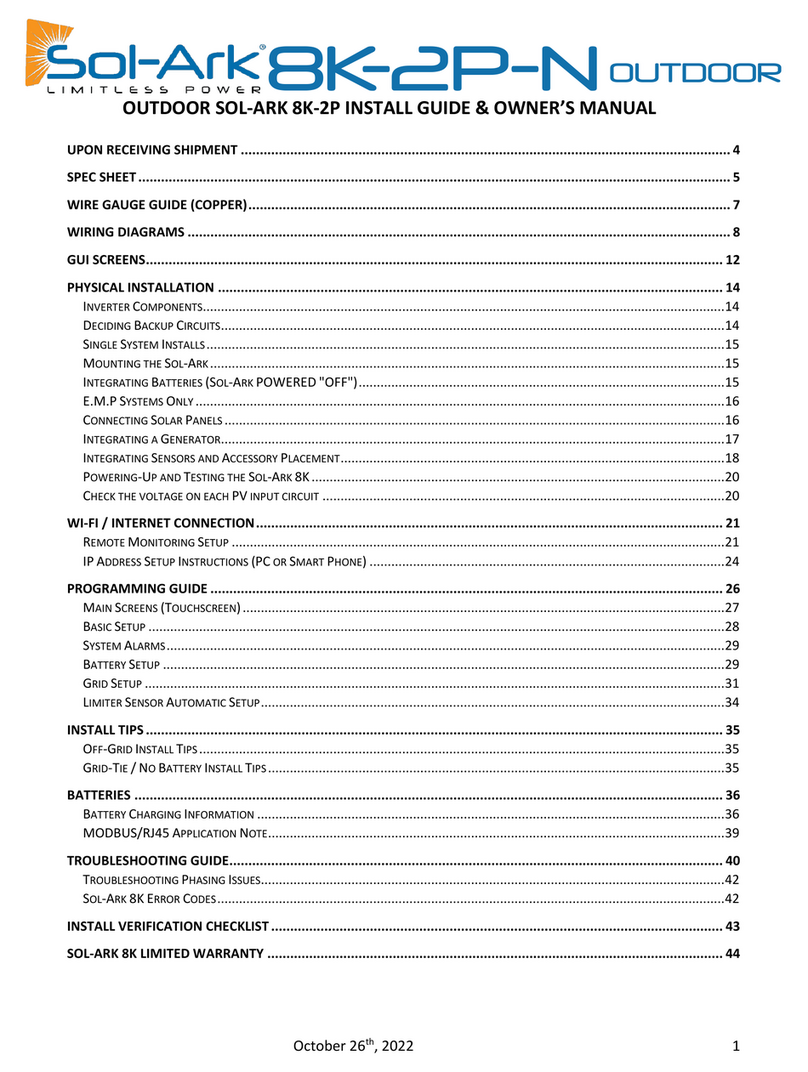
Solark
Solark 8K-2P-N Install Guide & Owner’s Manual

MQ Power
MQ Power DCA180SSJU WHISPERWATT SERIES Operation and parts manual
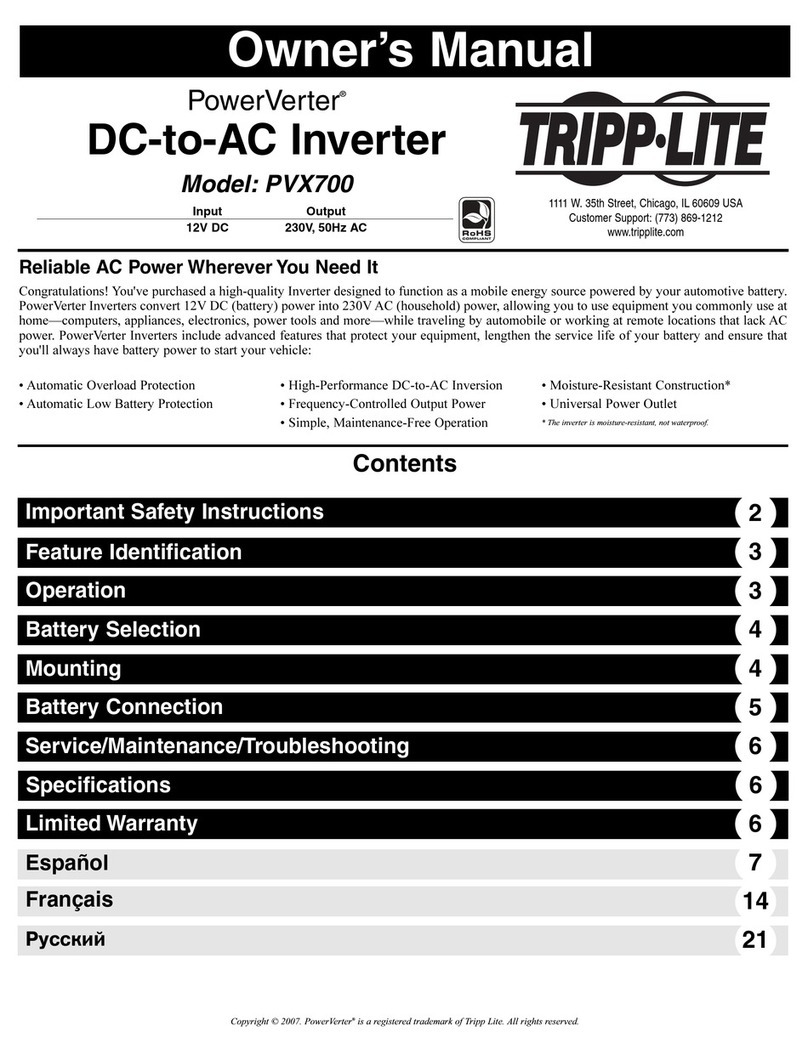
Tripp Lite
Tripp Lite PowerVerter PVX700 owner's manual

MasterPower
MasterPower BETA RHI 6K-48V 1P Series Commissioning Guide
